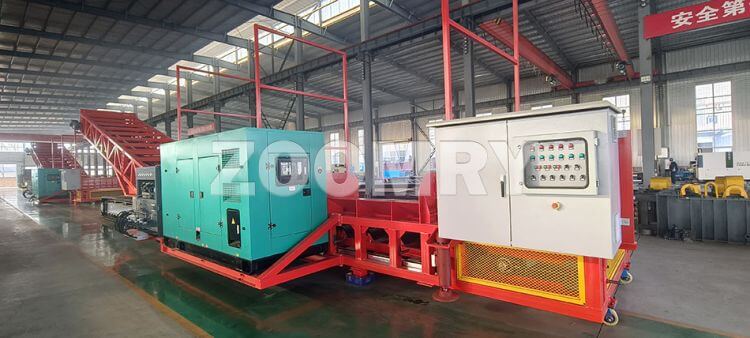In the technological advancement of bulk material handling, truck unloaders serve as critical equipment bridging transportation and production, with their operational stability directly impacting overall efficiency. As a global expert in bulk material conveying, ZOOMRY's analysis of data from over 200 global projects reveals that 75% of equipment performance losses stem from systematic operational maintenance deficiencies rather than inherent design flaws. This article will dissect industry-wide challenges and preventive solutions through the lens of technical parameter deviations and system mismatches, aiming to enhance equipment utilization and maintenance practices.
Power Mismatch in Equipment Selection
Operational Manifestations
Industry statistics indicate that 23% of unloaders suffer from power-to-capacity mismatches, characterized by:
- motor continuous load rate exceeding 85% (standard requirement ≤75%)
- CEMA standard verification deviations of 15%-28% in actual tension
- 1.8x over-limit roller rotation resistance when processing 1800tph material with 1400mm belt width
Solutions
ZOOMRY recommends a three-dimensional selection methodology: First conduct material property analysis (e.g., moisture content ≤8%, bulk density 1.6t/m³), then calculate processing capacity fluctuations (±15% redundancy advised), and finally perform CEMA-compliant driving force verification. For high-density materials, the ZRLD-TU1800 crawler-type unit with 600-1800tph dynamic adjustment capability is recommended for complex operational scenarios.

Hydraulic System Efficiency Degradation
Operational Manifestations
Hydraulic performance decline represents an industry-wide challenge, with laboratory tests demonstrating:
- 40% accelerated pump-valve wear rate per 10℃ oil temperature increase
- 300ms actuator response delay at NAS contamination levels exceeding Grade 7
- 35% heat dissipation efficiency reduction in 650L tanks under dusty conditions
Solutions
Establish a three-phase hydraulic maintenance system: Routine inspections focus on oil level and temperature monitoring (digital thermometers recommended), monthly maintenance includes radiator high-pressure cleaning and filter replacement, and annual overhaul requires pump-valve wear detection. For heavy-duty applications, ZOOMRY's 650L tank with plate heat exchangers maintains oil temperature at 55±3℃.
For inquiries regarding truck unloader operational issues, please contact us via:
- ZOOMRY Official Website
- +86 131-6401-6717
- oversea@zoomry.cn
Conveyor System Instability
Operational Manifestations
Belt stability directly affects MTBF (Mean Time Between Failures), with critical parameter deviations including:
- Self-aligning idler correction response time >5s (standard ≤2s)
- Cleaner contact pressure fluctuation >20N/cm (allowable ±5N/cm)
- Transition section material bias >15% (design threshold 5%)
Solutions
Implement dynamic alignment procedures: First use laser alignment instruments to calibrate head/tail pulleys (parallelism error ≤0.5mm), then install adjustable flow guides in the feeding section (material bias ≤5%), and finally upgrade to automatic correction devices with pressure sensors. ZOOMRY's polyurethane cleaners with backup brush systems reduce material residue to 0.2g/m².
Structural Component Abnormal Wear
Operational Manifestations
Material receiving system durability challenges are evidenced by:
- Q345B steel wear rate of 0.8mm/kt at 4m/s impact velocity
- 7x corrosion acceleration of 16Mn liners in acid-alkali environments
- 30% increased impact energy from 5° chute angle deviation
Solutions
Adopt composite protection measures: First install 16mm ceramic-steel composite liners (Rockwell hardness ≥85HRC) in 5.7m-wide hoppers, optimize chute angle to 55° for impact energy reduction, and add buffer idler groups to absorb 30% impact forces. Testing confirms this solution extends component lifespan to 5 years versus 8 months for standard steel plates.
Intelligent Control System Reliability
Operational Manifestations
Electrical system stability directly impacts equipment availability, with critical parameters including:
- PLC signal latency >200ms causing control disorders
- EMI interference intensity >60dBμV/m triggering malfunctions
- HMI refresh rate <30Hz resulting in operational lag
Solutions
Develop dual-redundancy control architecture: Begin by deploying CAT6 shielded twisted pair cabling (transmission delay ≤120ms), upgrade cabinets to IP66 protection with EMI shielding, and program dual emergency-stop logic. ZOOMRY's PLC modules maintain stability under 1.2GHz RF interference through EMC Level 4 certification.
Note: Certain functions and components require customization based on actual working conditions.
Truck unloader lifecycle management requires integrated "selection-operation-upgrade" technological systems. ZOOMRY's analysis of 200+ global projects demonstrates:
Efficiency Enhancement
Through preventive maintenance systems and OEE optimization models, equipment effectiveness reaches 92% (37% above industry baseline), with MTBF exceeding 8000 hours.
Cost Optimization
Standardized management reduces operational costs by 38%-42% over 10-year cycles, with hydraulic regeneration technology contributing 21% savings.
Specialized Adaptation
Arctic environments: ISO 21873-certified thermal systems (-50℃ cold-start success rate 100%)
Corrosive conditions: Teflon-coated components improve corrosion resistance by 70% (PH 1-13 validated)
Coastal applications: ASTM B117-compliant salt spray protection packages achieve 20,000 corrosion-free hours

 ZOOMRY
ZOOMRY

